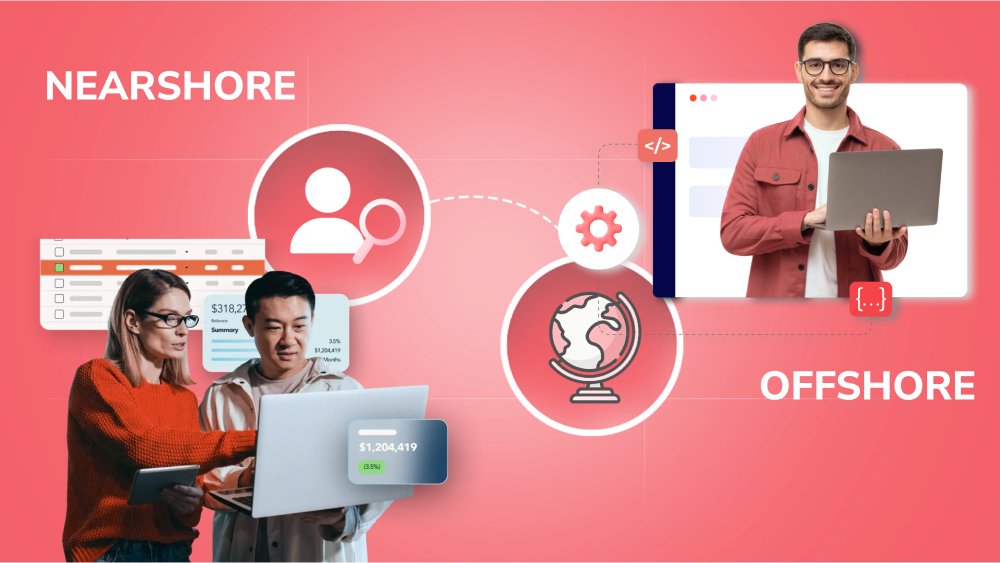IT Outsourcing Vendor Management Best Practices for Mutual Success
Stop chasing deliverables and fighting misalignment. Learn how to strengthen vendor management with our proven best practices.

Content Map
More chaptersIT outsourcing is a powerful strategy for accessing specialist talent, reducing costs, enhancing operational efficiency, and boosting productivity. However, it also brings inherent risks, such as noncompliance, security breaches, and potential reputational damage.
That’s why vendor selection and management have become mission-critical components of a successful IT outsourcing endeavor. To form strategic alliances that create impact, business owners need more than the right IT service vendors. Equally important is establishing mutually beneficial terms and conditions and maintaining positive long-term relationships with the outsourcing partners. In this article, we will guide you through vendor management best practices to build and maintain a productive partnership.
Key Takeaways:
- Vendor management is the strategic process of selecting, coordinating, and overseeing third-party service providers to ensure value, compliance, and performance.
- To manage outsourcing vendors effectively, establish a clear policy, conduct risk assessments, create detailed contracts, measure performance with KPIs, embrace Agile, streamline payments, and apply vendor tiering for smarter oversight.
- Effective relationship management enables you to prevent scope creep, missed deadlines, and vendor lock-in; minimize security risks and disruptions; reduce collaboration friction; and maximize outsourcing ROI through better control, cost-efficiency, and performance visibility.
What Is Vendor Management?
Simply put, vendor relationship management or supplier management refers to the systematic process of organizing and overseeing how you buy and use products or services (Such as non-core IT functions, custom software development, cloud infrastructure, technical support, etc.) from a service provider. In the context of IT or software development outsourcing, a vendor can be an individual (freelancer), a dedicated team, or a specialized outsourcing company. Vendors adhere to contractual obligations and are responsible for providing resources that the client companies require.

The vendor management process encompasses multiple aspects, ranging from vendor evaluation and selection, vendor onboarding, contract negotiation, and performance monitoring to risk mitigation and relationship cultivation. Also, it involves different activities. You should figure out what type of vendors you need, what you want from them, and how you’ll mitigate vendor risks. Then, you need to narrow down multiple vendors, choose the right one(s), monitor their performance – against set Key Performance Indicators (KPIs) – and review each vendor relationship, ensuring they still meet your needs.
Unlike general vendor management, this discipline specifically deals with the complexities of IT-related services where technical expertise, data security, and technological evolution are paramount. Therefore, managing IT vendors goes beyond transactional oversight. It demands a strategic approach that balances agility with control.
Key Best Practices for Managing Vendor Relationships Effectively
Remember that strong vendor partnerships are more than engagements between buyers and suppliers; they are mutually beneficial supplier relationships. If done well, it becomes a competitive advantage and one of the boosters for business growth. Still, managing vendors is no easy task. So, you will need a well-defined strategy and a proven process in order to pull it off. Also, strategic vendor management software can be useful in this process.

Here, we outline the key vendor management practices to help you not only build trust but also ensure accountability and foster continuous collaboration:
Develop a Vendor Management Policy
A well-defined policy serves as the foundation for open and consistent communication between you and your vendors. Its goal is to outline the minimum standards and expectations that service providers must meet to maintain a productive and compliant partnership.

A clear and effective vendor management policy must cover these key components:
- Selection Criteria: Standards for due diligence based on technical capabilities, reliability, scalability, and fit with your business needs.
- Onboarding Procedures: A structured process to integrate new vendors into your systems, workflows, and communication protocols.
- Performance Expectations: Specific supplier performance metrics and service level agreements (SLAs) that define acceptable performance, such as delivery timelines, product quality, and responsiveness.
- Risk Management Protocols: Defined procedures to assess, monitor, and mitigate potential risks, including data security, legal compliance, and service continuity.
- Communication Guidelines: Agreed transparent communication channels, formats, and frequency for reporting progress, raising issues, and providing feedback.
A vendor management policy can also help you identify risks and implement strategies to prevent those from occurring. However, note that you should regularly review and update your vendor management policy. Doing this will ensure alignment with evolving organizational goals, regulatory environments, and market conditions while guaranteeing your vendors adhere to your processes and standards.
Conduct Thorough Risk Assessments
According to the Third-Party Risk Management Outlook 2022 by KPMG, 73 percent of respondents experienced at least one major disruption due to a third party in the past three years. The two biggest issues for outsourcing companies are security and non-compliance.

To mitigate risk, assess potential vendors across different dimensions. This process involves identifying the threats that are likely to occur during the vendor relationships. Evaluate the severity of each risk; describe their impact on your business, including who would be affected, in what way, and for how long. Then, outline KPIs for the most critical risks and monitor your vendor’s performance to ensure they are meeting those risk-related KPIs.
Check these key risk domains:
- Compliance Adherence: Verify alignment with regulatory requirements such as GDPR, HIPAA, ISO 27001, and other industry-specific standards.
- Security Posture: Evaluate the strength of the vendor’s cybersecurity framework, including encryption, access controls, incident response, and ongoing monitoring.
- Financial Stability: It is important to check the vendor’s financial health to confirm their ability to deliver consistent service over time.
- Operational Resilience: Assess their capacity to handle supply chain disruptions in terms of business continuity planning and disaster recovery readiness.
Establish Detailed Contracts
Negotiating contracts is a crucial step in managing vendor relationships. Normally, service providers will work with you on vendor agreements in which they outline and clarify unfamiliar details, specifications, and mutually beneficial terms:

- Scope of Work: A detailed description of deliverables, services, and timelines.
- Service Level Agreements (SLAs): Measurable performance metrics and penalties for unmet standards.
- Data Handling and Security Terms: Clauses that ensure compliance with your organization’s data governance policies and relevant legal standards.
- Termination Clauses: Defined conditions under which the agreement can be ended, including exit procedures and transition support.
If the vendor plans to outsource (some work) to a fourth party, then that party should abide by the same standards as the vendor.
Make sure you thoroughly read the agreement and that both parties are on the same page. Have the vendor clarify unclear information. And don’t sign anything until you fully understand the terms and conditions. In this case, you may need a lawyer to explain the legal provisions and compliance requirements.
Use Metrics to Measure Vendor Performance
KPIs help you measure and monitor vendor performance, as well as compare to agreed benchmarks. Since most IT vendors use proprietary project management systems, they have their own KPIs.

Common software development KPIs include:
- Lead Time: How long it takes to turn an idea into a product.
- Cycle Time: How long it takes for developers to complete individual tasks within the lead time.
- Sprint Velocity: Measures how many software components are completed within one sprint (a set period of time in which a specific amount of work is done).
- Code Churn: How many lines of code are written, edited, or deleted within a set period of time.
- Mean Time Between Failures (MTBF): Average time between each instance of a repairable system failure.
- Mean Time to Recover/Repair (MTTR): Average time it takes to recover or repair a system failure.
As part of the vendor management process, you are not expected to measure and monitor these KPIs, but you are expected to choose a vendor that does.
Streamline Vendor Payments
One of the key practices in managing and maintaining strong vendor relationships is to ensure a streamlined, on-time payment process with minimal administrative friction. It is crucial for improving vendor satisfaction, reducing disputes, and strengthening long-term partnerships. On the other hand, late or inconsistent payments may erode trust, stall work, trigger contractual penalties, or, even worse, damage your reputation as a client.
Build a Vendor Tiering System
Not all vendors are created equal, so you cannot manage them in the same way. Therefore, it is essential to segment vendors by strategic importance when you work with multiple service providers simultaneously. This facilitates efficient resource allocation and focused governance.

With a tiering model, business owners can categorize their partners by priority, based on business criticality, risk level, scope of service, and contribution to your operations.
- High-Tier: These vendors are long-term, strategic partners whose contributions influence core business outcomes. E.g., end-to-end software development or staff augmentation services.
- Middle-Tier: These are service vendors who provide ongoing services with less impact or risk. They tend to support your operations with specialized, supplemental, or project-specific services rather than core infrastructure or product ownership. E.g., UI/UX design services or QA and testing services.
- Low-Tier: Third-level vendors are non-critical suppliers of commoditized or one-off services that are used on-demand and managed with minimal oversight. E.g., logo or graphic design services.
High-tier vendors may demand executive oversight, co-innovation initiatives, and more, while lower-tier vendors can be monitored with simpler procedures.
Why Effective Vendor Management Matters
In IT outsourcing, vendor management goes far beyond contract management and enforcement. It is a strategic practice made with effort, and it delivers tangible, practical benefits across dimensions:

Avoid Scope Creep, Missed Deadlines, and Hidden Costs
When the roles and responsibilities of both parties, as well as project scopes, are well-defined and monitored, it will be harder for deliverables to drift or timelines to stretch unchecked. You will not need to chase your vendors for status updates or discover undone or unapproved work late in the flow. Instead, you are always kept posted, and your projects roll on schedule.
Moreover, if you manage your vendor ecosystem well enough, you not only can avoid scope creep but also eliminate hidden costs. By clearly defining deliverables, timelines, and pricing models, you gain better control over your budget and vendor spend.
Prevent Disruptions from Vendor Turnover
In IT outsourcing, vendors may come and go, and it is inevitable. In order not to suffer from losing critical knowledge, technical assets, or workflow continuity when a vendor departs, you need clear vendor segmentation and governance models from the outset.
Structured onboarding procedures should include comprehensive documentation handover, access to shared repositories, and contributions to a centralized platform. These steps are crucial to ensure your team retains full ownership of vital project assets. Additionally, establish predefined transition plans, such as backup teams, shadow onboarding, and formal offboarding protocols, to enable seamless vendor replacements when needed, even in the event of sudden changes. This proactive approach minimizes operational disruptions and safeguards business continuity.
Moreover, good vendor governance can keep you from getting trapped in a bad deal and avoid vendor lock-in - the dependence on one single service provider and being unable to switch without overhead cost or disruption.
Protect Against Security Gaps
Outsourcing vendors who are not properly vetted or monitored may become weak links in your cybersecurity posture. Fortunately, an effective vendor management process ensures enforcing strict security protocols, such as background checks, controlled access, and ongoing compliance reviews. This minimizes vulnerabilities and closes the doors before cybersecurity risks walk in.
Maximize ROI on Outsourcing
When you can proactively manage your vendors, you can get more than just timely delivery. Clear deliverables, well-defined expectations, and consistent communication are tangible signs you can recognize. These help to reduce ambiguity, minimize revisions, and ensure that time and resources are used efficiently. This alignment accelerates development cycles, eliminates redundant work, and helps avoid costly rework caused by miscommunication or shifting requirements.
In addition, vendor compliance and adherence to agreed-upon standards also create visibility into performance metrics and spending patterns, which helps you identify cost-saving opportunities. Whether it is recognizing underutilized resources, negotiating better rates based on performance, or consolidating overlapping vendor services, you can proactively trim unnecessary costs without compromising quality.
Reduce Collaboration Friction
Even the most capable service provider can fall short if communication and coordination are poorly handled. If done wrong or carelessly, misaligned expectations, delayed feedback, and unclear responsibilities may happen, and they lead to misunderstandings, project slowdowns, and frustration on both sides. On the contrary, structured engagement helps eliminate and ease these pain points by establishing effective communication protocols. For example, regular check-ins, feedback loops, escalation paths, and shared collaboration tools.
Final Thoughts
In a nutshell, mastering IT outsourcing vendor management is not only about overseeing deliverables or enforcing contracts. It is about building resilient, value-driven relationships that support long-term growth for you as well as your partner. Now that you have learned about the key best practices outlined above, you know how to not only evaluate vendors but also build, manage, and maintain partnerships that last.

We understand that effective IT outsourcing vendor relations are built on more than just technical capability. A trusted partner is one of the important conditions for any strategic partnerships, and Orient Software is the one.
At Orient, we offer not only deep technical expertise but also a collaborative, transparent approach tailored to your business needs. Our proven frameworks for onboarding, communication, performance tracking, and knowledge transfer ensure our clients maintain full visibility and control no matter the complexity or scale of the engagement. As a leading software development service provider based in Vietnam, we have been empowering hundreds of clients from all over the world and delivering over 200 successful projects. Many of our valued clients choose us as their reliable partner for a comprehensive suite of services and long-term success.
Whether you are in search of augmenting your technical team, accelerating digital transformation, or kickstarting a brand-new project, we are willing to accompany you toward success. Get in touch to explore how Orient Software can support your vendor management goals and elevate your next IT initiative.







